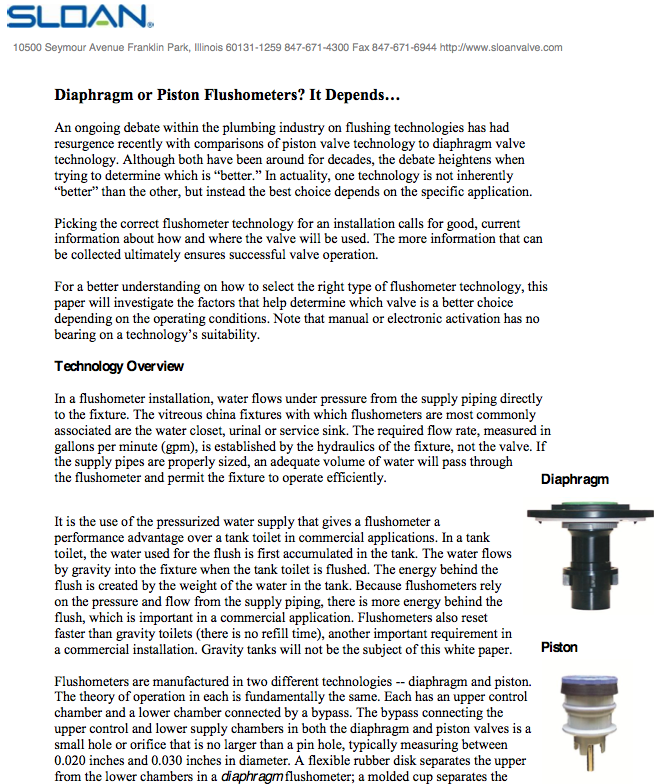How do you know when to choose diaphragm vs. piston flushometer valve technology? Sloan has issued a new white paper that discusses the differences between diaphragm and piston valve flushing technologies and includes charts that show under which operating conditions to specify one type over the other.
“Diaphragm and piston flush valves each have their strengths and are best suited for different environmental conditions,” says Mike Gipson, Flushometer Product Line Manager for Sloan. “It’s important to assess the environment before choosing to install diaphragm or piston technology.”
In addition to illustrating the mechanical differences between diaphragm and piston flushometers, the white paper highlights considerations that impact which type of technology is most appropriate for various restroom environments, including:
- High or low restroom traffic
- Water quality, including the pH of the water and chlorine concentration
- Operating conditions, such as high or low water pressure systems
Sloan invented the diaphragm flush valve more than 100 years ago and then introduced piston valves about 20 years later. Today, Sloan manufactures both diaphragm and piston flush valves in sensor-activated and manual models. Diaphragm flushometers include the Royal, UPPERCUT, Regal XL and Sloan brand valves; the Crown and GEM•2 valves are piston operated. Sloan offers flushometers for every type of environment from normal restroom applications to extremely harsh water conditions.
To help you determine which type of flushometer valve is best suited for the variety of restroom environments, download a PDF of the “Diaphragm or Piston Flushometers? It Depends...” white paper at http://www.sloanvalve.com/Water_Efficiency/SLV3583-Diaphragm_Piston_White-Paper.pdf. BD+C
Related Stories
| Mar 1, 2014
Dramatic fractal roof highlights SOM's new Mumbai airport terminal [slideshow]
The terminal merges new technology and traditional regional architecture, notably in the fractal roof canopy that runs throughout the terminal.
| Feb 28, 2014
Six finalists selected in design competition for Canadian Holocaust monument
David Adjaye and Daniel Libeskind are among the finalists for the National Holocaust Monument, planned near the Canadian War Museum in Ottawa.
| Feb 27, 2014
Gensler reveals 44 design trends for the next decade
The 82-page report covers dozens of emerging trends in healthcare, commercial office, hospitality, tall buildings, and more.
| Feb 27, 2014
Target converts former prison dump into latest big-box store
Target's new San Rafael, Calif., location was built on the site of the former San Quentin prison dump.
| Feb 27, 2014
Open or private offices? It depends on the business plan
Open layouts are grabbing headlines as a hallmark of the new workplace—think the Google campus or Facebook's headquarters. And for smaller-scale operations, open designs are often lauded for being less expensive than private office plans. But does that mean all offices should have an open layout?
| Feb 27, 2014
3 reasons to apply computational fluid dynamics on your next project
From right-sizing mechanical systems to understanding the impact of design alternatives, CFD offers a host of benefits for the Building Team.
| Feb 27, 2014
12 facts about heat-treated glass: Why stronger isn’t always better
Glass is heat-treated for two reasons: the first is to increase its strength to resist external stresses such as wind and snow loads, or thermal loads caused by the sun’s energy. The second is to temper glass so that it meets safety glazing requirements defined by applicable codes or federal standards.
| Feb 27, 2014
Metal Construction Association introduces two Environmental Product Declarations
Two Environmental Product Declarations (EPD), one for Metal Composite Material Panels and one for Roll Formed Steel Panels for Roofs and Walls, are now available free of charge from the Metal Construction Association (MCA) on its website.
| Feb 27, 2014
Bluebeam Software launches Revu 12 for better field-ready document management and project collaboration
The latest version of the company’s flagship solution better enables users in document-intensive industries to digitally collaborate on project documents and more easily connect the office to the field.
| Feb 27, 2014
PocketCake lunches CPU designed for virtual reality simulations
The company's Virtual Reality Simulation Converter Assembly is three times more powerful than the average high-performance computer and allows for up to eight people to experience a virtual reality simulation at the same time.

















